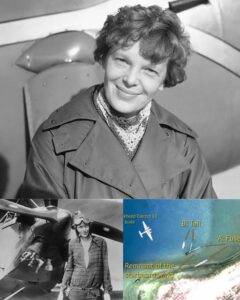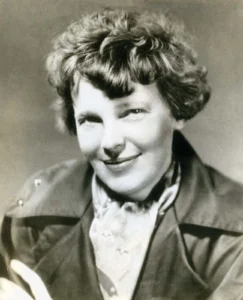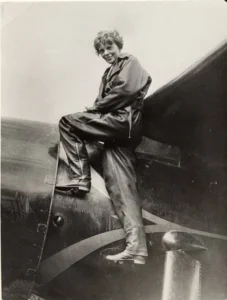New Evidence May Finally Solve the 88-Year-Old Mystery of Amelia Earhart’s Disappearance

For nearly nine decades, the disappearance of pioneering aviator Amelia Earhart has baffled historians, scientists, and aviation enthusiasts alike. As one of the most iconic figures in aviation history, her vanishing during an ambitious round-the-world flight in 1937 has inspired generations of theories, expeditions, and debates.
Now, nearly 88 years later, a team of researchers believes they may have made the most significant breakthrough yet. Using satellite imagery, archival analysis, and field data, they claim to have identified what could be the final resting place of Earhart’s long-lost Lockheed Electra aircraft—and possibly the woman herself.
A Trailblazing Spirit Lost to Time
Amelia Earhart wasn’t just a pilot—she was a symbol of fearless ambition. From her earliest days, she was drawn to challenges few women dared to take on. After witnessing a stunt pilot at a county fair take flight, a young Earhart knew she wanted to soar above convention—and gravity.
She became only the 16th woman in history to receive a pilot’s license and, in 1932, made history as the first woman to fly solo across the Atlantic Ocean. Her fame soared. But Earhart’s ambitions weren’t satisfied by crossing one ocean—she set her sights on circumnavigating the entire globe.

With navigator Fred Noonan by her side, Earhart embarked on a nearly 30,000-mile journey around the equator—an unprecedented feat at the time. On June 1, 1937, they took off from California. For six weeks, their journey took them through the skies over Central and South America, Africa, the Indian subcontinent, and Southeast Asia.
But it was the Pacific leg of the trip that would become legendary—for all the wrong reasons.
The Fateful Flight to Howland Island
On July 2, 1937, Earhart and Noonan took off from Lae, New Guinea, aiming to reach the tiny speck of land known as Howland Island. It was a 20-hour flight over vast, open ocean—an extremely difficult navigation challenge, especially with the primitive tools of the era.
The U.S. Coast Guard was actively assisting with the mission, stationed near Howland Island to help guide the Electra in with radio signals. But something went wrong. Earhart’s final transmissions indicated she couldn’t see the island and was running low on fuel.
One theory suggests that Fred Noonan may have miscalculated their position due to the International Date Line—throwing off celestial navigation and putting them miles off course. Some researchers believe they may have passed just 70 miles from Gardner Island (now Nikumaroro in Kiribati) before disappearing entirely.
Earhart’s last words to the Coast Guard ship were calm but urgent: “We are running north and south.” After that, nothing.
Crabs, Bones, and Forgotten Clues
Over the decades, dozens of theories emerged—from crashing into the ocean to being captured by the Japanese. But one theory that gained traction pointed to Nikumaroro Island. It’s here that British colonists in 1940 discovered 13 bones and a partial skull, believed by some to be Earhart’s. However, initial tests claimed the remains belonged to a man—though modern analysis later questioned that conclusion.

One of the more macabre theories involves the island’s infamous coconut crabs—giant land crabs that can grow up to three feet in length. Some believe that Earhart may have survived the crash for several days or even weeks, only to succumb to the elements—and eventually, to nature. According to National Geographic, forensic evidence suggests that coconut crabs may have scattered her remains.
Further supporting this grim theory, researchers discovered remnants of American-made objects, including a mirror from a compact, pieces of metal consistent with aircraft wreckage, and even a glass medicine vial—possibly from Earhart’s first aid kit.
The Breakthrough: A Shadow in the Sand
On July 2, 2025—exactly 88 years to the day since Earhart disappeared—researchers made a stunning announcement. A satellite image captured near Nikumaroro Island revealed what appears to be the outline of an aircraft half-buried in the sand. The image, taken after a powerful 2015 cyclone shifted large amounts of beach sediment, shows a distinct silhouette matching the dimensions of a Lockheed 10-E Electra.
This finding has sparked a renewed expedition effort. Purdue University, which had previously sponsored Earhart’s historic journey, announced it would be funding a new mission to Nikumaroro in November 2025.
“We believe we owe it to Amelia and her legacy at Purdue to fulfill her wishes, if possible—to bring the Electra home,” said Steve Schultz, the university’s general counsel.
Archaeologist Richard Pettigrew, executive director of the Archaeological Legacy Institute, emphasized the potential significance of the discovery: “The object’s size, material composition, and location all line up with Earhart’s final radio signals and intended flight path. This could be the most compelling lead we’ve had in decades.”
Doubts and Skepticism Persist
Not everyone is convinced. Ric Gillespie, director of the International Group for Historic Aircraft Recovery (TIGHAR), has been investigating Earhart’s disappearance for years. He reviewed the same satellite image and concluded the object may simply be a coconut tree and root ball displaced by the storm.
“This image alone isn’t enough,” Gillespie said. “It needs to be verified on the ground.”

Still, Gillespie’s own team had previously visited Nikumaroro in 2017, bringing forensic dogs trained to detect human remains. The dogs signaled at a specific location near the island’s southeast end—just yards from where the satellite photo was taken.
A Mystery Nearly Resolved?
Despite the mystery’s enduring allure, experts say we may be closer than ever to the truth. Pettigrew remains optimistic. “We believe this is the best chance we’ve ever had to finally close the case. There’s too much evidence now to ignore.”
If confirmed, the discovery would not only solve one of the greatest aviation mysteries of all time but also honor the legacy of a woman who broke barriers in a male-dominated field—and whose courage continues to inspire.
For many, Amelia Earhart’s story is about more than a missing plane. It’s about a fearless explorer, a woman ahead of her time, who dared to chase the horizon—until the very end.